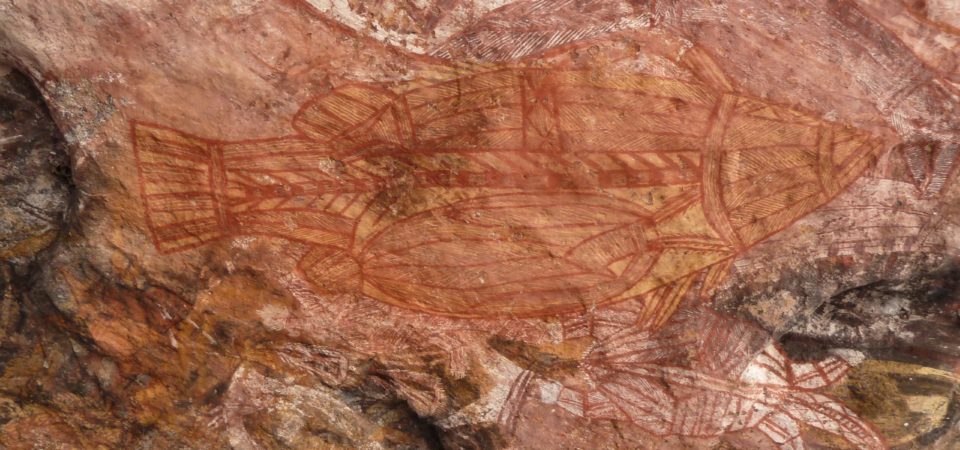Humans entered Australia some 50,000 years ago and quickly dispersed over the entire continent, developing complex cultures with an enviable capacity for living in diverse and often hostile environments. They evolved a complex spiritual life, and maintained the longest known artistic tradition on Earth reaching back approximately 45,000 years.
Aboriginal societies have been thriving in Australia despite climatic changes, which created an ice age and mega-droughts with the corresponding changes in habitable land and, most recently, despite the invasion of Europeans. Population densities no doubt increased during times of abundant food or restriction in habitat, which will have led to resource competition and warfare. Nevertheless Aboriginal societies have continuously survived for some five millennia, without destroying their resource base and while maintaining their cultural traditions. That Aboriginal culture has thrived for so long is surely a testament to its sustainability.
All this is in stark contrast to the Europeans who in a mere few hundred years profoundly altered most of the continent and, in the process, created many ecological disasters. Widespread soil salination and erosion, deforestation, over-exploitation of water resources, rampant feral animal and exotic weed infestations, extinction of many native animal populations and species, coastal pollution and over-fishing are just some of the current problems created by the Europeans and their technologies. Modern Australia will struggle to sustain its continuously increasing population
This is not to say that Aboriginals did not have substantial impacts on the ecosystems of Australia, both directly, through their use of fire, and indirectly by having a role in the demise of the Australian representatives of the Pleistocene megafauna, which included the giant kangaroos, echidnas, wombats and platypus. This role remains controversial as there were substantial changes in the Australian climate and sea levels throughout the timescale of the megafauna extinctions so that both climate and humans probably had deleterious effects on the survivorship of these large animals.
Aboriginal rock art provides clues about the contact between humans and the megafauna as a variety of paintings depict recognisable renditions of marsupial lions and Genyornis, a giant flightless bird, and careful dating suggests that humans and the megafauna co-existed in some places for many thousands of years. One painting from the NW Kimberley region shows an interaction between an Aboriginal and a marsupial lion. The Aboriginal is either defending himself from an attack using a spear, or hunting the lion. Thus cave art suggests not only the coexistence of Aboriginals with megafauna but also physical interactions with it.
Aboriginal rock art, notably in northern Australia, especially Arnhem Land, has been – and still is – a medium which was important in facilitating Aboriginal sustainability, providing information on the type and location of food resources, medicines, poisons, and where to find sources of drinking water. Probably the world’s first maps are those which Aboriginals etched into or painted onto rocks, showing the relationships of land formations and temporary and permanent water holes.
The photos here were taken while on a tour of rock art near Injalak with a local Aboriginal guide who explained many of the images. The first reveals a freshwater fish species, the Saratoga, and a long necked turtle, indicating the availability of these delicacies and drinking water in an area that, by interpreting the time-series represented by surrounding, carefully dated images, showed that it previously had neither. The second depicts a leech with two hand prints which is a warning to newcomers about the hazard of leeches nearby.
Aboriginal communities still use the knowledge portrayed in the ochre drawings and the oral histories passed down through the millennia. We are not so naïve as to suggest that we should all adopt their way of life, but we can learn much about the management of the land and its coastlines from them. Lessons of sustainability learned and honed through thousands of years of cultural evolution on the Australian continent are available for us all.
MAHB-UTS Blogs are a joint venture between the University of Technology Sydney and the Millennium Alliance for Humanity and the Biosphere. Questions should be directed to joan@mahbonline.org
MAHB Blog: https://mahb.stanford.edu/blog/sustainable-societies/
The views and opinions expressed through the MAHB Website are those of the contributing authors and do not necessarily reflect an official position of the MAHB. The MAHB aims to share a range of perspectives and welcomes the discussions that they prompt.
